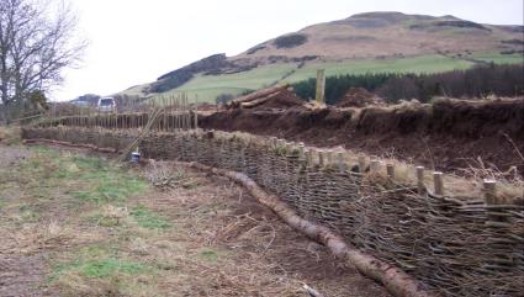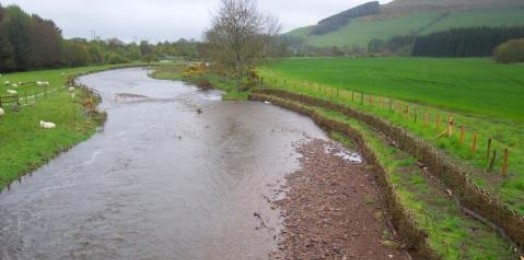Supporting guidance for Restoring (Protecting) River Banks
This is an old version of the page
Date published: 26 January, 2017
Date superseded: 10 October, 2018
For recent changes to this guidance, please see the bottom of the page.

River banks provide valuable wildlife habitat that typically supports a diverse range of plant and animal species. They supply shelter, food and shade and protect the aquatic environment from polluted surface runoff. Riparian vegetation and the roots of that vegetation help to maintain bank stability and prevent excessive river bank erosion, helping to prevent excessive gravel deposition and flooding downstream.
While naturally occurring erosion of river banks is an important river process that maintains sediment supply to the watercourse, renews habitats and reduces the energy of river flows, in some cases human activity may increase levels of erosion to an unnaturally high level. For example, livestock can destabilise the river bank through poaching and through the removal of vegetation.
The purpose of this item is to restore river banks which are vulnerable to erosion due to historic land use which has depleted the river bank of its natural riparian vegetation. Such areas may have been damaged by historic livestock poaching, historic livestock grazing, and/or loss of large shrubs / trees or other deep rooted vegetation which would otherwise naturally be present. It will be particularly useful where flooding is an issue downstream due to excessive gravel deposition.

In many cases, simply fencing off the eroded bank will allow the river bank to revegetate and stabilise and therefore this fencing should be the first remedial action considered. Support will only be provide in places where fencing has shown to be, or is likely to be, insufficient.
This item will fund, where appropriate, protection of the river bank using one of the following green bank protection techniques:
- willow spiling
- plant roll revetment
- hurdle / coir matting
- engineered log jams
Works should only be carried out if doing so does not increase flooding to properties or infrastructure (roads etc), upstream, downstream or on the other side of the watercourse. This will have been confirmed through the preworks assessments described below.
Identifying the opportunity
An organisation such as the Scottish Environment Protection Agency, a rivers / fisheries trust or a local authority may have contacted you already identifying a site where restoring a river bank may benefit flood risk downstream. Alternatively, you may have identified the opportunity yourself.
Where the eroded river bank extends into land owned by a neighbour, you should seek agreement to undertake this work together with them. In such instances, you should consider seeking the help of a facilitator. Facilitation fees and some of the pre works assessments (described below) can be paid for by the co-operative action fund.
Pre-works assessments and approvals
Certain pre-works assessments andapprovals will be required prior to commencing work on the ground. These should include as a minimum:
1) Options appraisal
This assessment identifies the causes of the erosion and whether it is appropriate to restore the river bank. Where deemed appropriate, the assessment reviews the options to reprofile and evaluates their relative advantages and disadvantages. It is informed by a survey of the river reach in question. It identifies a preferred option (in consultation with the land manager and other stakeholders) and outlines additional assessments / surveys required to progress the preferred option.
2) Design and approvals
This includes details of the design of the works, including approach to construction, feasibility of the works, potential impacts, estimated costs, method statement and maintenance requirements. In certain circumstances this may include surveys, such as topographic, hydromorphological and habitats / species surveys, and all relevant consents and approvals.
Note: Consents and approvals
You will need to adhere to all relevant regulations and obtain licenses as appropriate. These include:
You should also confirm that no protected species or habitats are at risk from the works. Any works within a designated site or where there is the potential to affect protected habitats and species will require approval from Scottish Natural Heritage.
What you need to do
Your initial application should include a plan showing the location of the river banks you propose to protect on a 1:2,500 map. Preworks assessments and designs should be provided prior to any works being carried out, including confirmation that the selected technique is appropriate to the reach in question. You will also need to demonstrate that there is no poaching of land within five metres of the top of the river bank, preferably as a result of fencing off the reach in question. Fencing or other means of protection against damage from grazing animals must be put in place wherever live trees have been used.
Work should preferably be carried out by a contractor with experience of working with rivers, from late spring to early autumn to reduce the risk of damage to the river environment and to allow time for vegetation to establish before winter. This is with the exception of works using live willow which should be carried out in the dormant season i.e. over the winter months. Care should be taken to prevent soils entering the watercourse during the works and vegetative cover should be allowed to re-establish on any bare ground remaining after the works are complete.
Note that these techniques do involve a risk of failure as they take time and care to become established and can be vulnerable to damage during large floods. Thus matching the size and scale of the measure used to the width and energy of the stream will be critical.
Further information on individual techniques is provided below.
(i) Willow spilling
This technique uses live willow rods of around two to seven metres length (depending on the energy of the river) supported by live willow stakes of around 2 metres to form a vertical ‘wall’ of live willows.
Live willow rods should be weaved between live willow stakes set into the affected bank at regular intervals of around 50 centimetres. The space behind the willow wall to the existing bank should then be back-filled with soil, with additional live willow stakes driven into the soil. A log 'toe' can also be installed at river level to reduce erosion. Osier willow (Salix viminalis) or goat willow (Salix caprea) should be used where available as these are considered to be the most appropriate willow species for this process, though local knowledge should also be sought.
Work should be carried out in the winter months (between November and April) when willows are dormant. This measure can be used on most river banks, but should not be employed in very fast flowing watercourses. You should refer to the Scottish Environment Protection Agency guidance on reducing river bank erosion below for more details of the specific approach that may be appropriate.
(ii) Plant roll revetment
This technique involves the installation of a flexible revetment, made up of rock rolls and plant rolls, at the toe of the river bank. The primary purpose of the revetment is to resist undercutting.
Plant rolls are composed of dense coir within which appropriate aquatic species can be pre-grown while rock rolls are composed of crushed rock. Plant rolls should be set out at low water level and wedged tight up against the rock rolls by driving stakes at a suitable angle along the rear of the rolls.
This technique is suitable for low energy rivers and where the toe of the bank is permanently damp.
(iii) Hurdle and coir matting
This technique involves the use of use of biodegradable materials to create a facing that protects a reprofiled river bank from erosion. The river bank should first be re-profiled to a 1 in 3 slope (at least).
Woven coir matting and / or willow hurdles (preconstructed woven panels of willow) are held in place by wooden or wire pegs, or live willow stakes. Turf underneath the matting speeds up vegetation growth, or alternatively grass seed is spread beneath the matting. Single willow hurdles can be pinned down at each end of coir matting for extra security.
(iv) Engineered log jams
This technique typically involves protecting river banks using trees, or parts of trees, including root wads, brash, stakes made of live willow, and willow spiling.
The primary goal of these structures is to mimic the function of naturally occurring log jams, such as altering flow patterns or trapping sediment. You should refer to the Scottish Environment Protection Agency guidance on reducing river bank erosion below for more details of the specific approach that may be appropriate.
Maintenance
Willow spiling will require regular maintenance to avoid excessive growth of vegetation and will need to be coppiced every two years. If not, there is a tendency for the willows to topple into the river and further destabilise the river bank.
Bank protection is most vulnerable at the upstream and downstream ends and therefore you should check regularly in the first year that this is not being undermined. Early, and relatively straight forward, remedial / repair work can avoid the risk of the whole scheme being compromised over time. Whichever technique is used, you should continue to ensure that livestock cannot access within five metres of the river bank.
How can you add value
Consider adopting this measure with other land management options, such as native tree planting. Also consider working together with your neighbours and accessing the co-operation action fund for funds to appoint a facilitator to oversee this process for you.
Further information
Guidance documents
- Scottish Environment Protection Agency - Reducing River Bank Erosion: A Best Practice Guide for Farmers and Other Land Managers
- Scottish Environment Protection Agency – Engineering in the Water Environment – Good Practice Guides
- The Scottish Rivers Handbook: A Guide to the Physical Character of Scotland’s Rivers – Perfect, C., Addy, S. and Gilvear, D. (2013)
- River Restoration Centre – Manual of River Restoration Techniques
- Environment Agency – Water Framework Directive (WFD) Mitigation Measures Online Manual
Case study
Recent changes
| Section | Change |
|---|---|
| Introduction | Guidance for restoring river banks expanded on |
| Identifying the opportunity | Minor content change |
| Pre-works assessments and approvals | Minor content changes |
| What you need to do | Guidance expanded on across section |
| Further information | Link added to 'Scottish Environment Protection Agency - Reducing River Bank Erosion: A Best Practice Guide for Farmers and Other Land Managers' |
